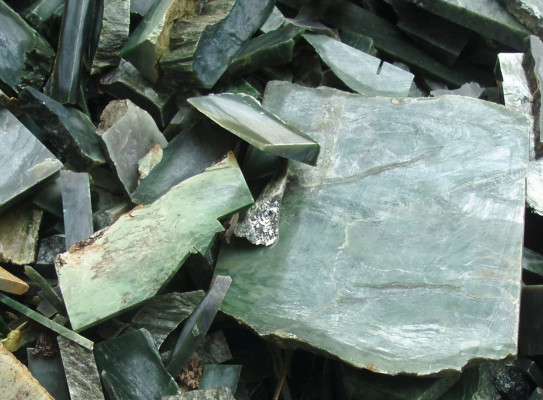Why is pounamu so tough?

Research into the special properties of pounamu has received funding from Rangahau a Marsden (the Marsden Fund).
One of four Marsden standard projects funded this year, the study focuses on weaving materials science and mātauranga Māori to jointly paint a picture about the special physical properties and uses of pounamu (Aotearoa’s nephrite jade).
Working with Ngāi Tahu, pounamu artisans and colleagues from the University of Otago, the project is the next step for the legacy of the Beck International Jade Research Collection, which was vested with GNS Science by Russell Beck and Te Rūnanga o Ngāi Tahu in 2017.
Titled, Why is pounamu tough? Using materials science and mātauranga Māori to explain the special physical properties and uses of nephrite jade, GNS scientists Dr Simon Cox and Dr Nick Mortimer will lead the materials science aspects of the colloboration.
As a Ngāi Tahu whānau member involved in supporting GNS for many years, Te Rūnanga o Ngāti Waewae Chair Francois Tumahai touches on the significance of sharing insights into pounamu. “The central outcome of this kaupapa is the two-way transfer of knowledge that will occur between the scientists and those Ngāi Tahu whānau members involved."
Scientists drill down on pounamu properties | Te Ao Tapatahi
Why is pounamu so tough? That’s a question for the kaitiaki of this taonga, Ngāi Tahu, who will be working alongside a team from GNS Science

Ultimately, it presents a fully funded opportunity for our people to upskill and broaden their knowledge base about something that is of huge significance to our iwi.

Dr Cox says in Aotearoa, pounamu is a tāonga and the subject of much mātauranga and the project has been built on over nearly two decades of pounamu research together with Ngāi Tahu. “Long-term aspirations for research on pounamu were discussed between Ngāi Tahu elders and GNS Science at the Beck International Jade Research Collection launch in 2017, where ideas for this project germinated.

It is renowned for its extreme toughness compared to other rocks, which is why it was historically revered so highly as a tool that holds a sharp edge. It also makes it very suitable for artisanal work such as carving and shaping.
"We all have a lot of theories to explain its special properties," Dr Cox says. "But this gives us the platform to explore it further using state-of-the-art materials science and iwi cultural knowledge to form a larger picture of pounamu use over time. Knowledge transfer will be two-way: bringing together scientists who are unfamiliar with the carving properties or history of various samples and pounamu artisans who have yet to include physical science data in their work. Ngāi Tahu’s kaupapa and tikanga around their tino tāonga, as well as mātauranga on pounamu, are integral to research success and two-way knowledge transfer.”

It is hoped that it will be useful in informing the selection and cutting process of high-quality pounamu for carving and illuminate future development of super-tough synthetic materials.
“With its cultural, geological, archaeological and materials science significance, this project could rewrite the jade textbooks of the world and lead to better management of this precious resource,” Dr Cox says.
As results come in, public talks, hui and communication of results are important to the project group. Dr Cox and Dr Mortimer have recently given three interactive talks at Otago Museum as part of The Kura Pounamu: Our Treasured Stone exhibition called, Understanding Stone: Pounamu’s Geology.

Nephrite jade and pounamu are unusual rocks in that they have metal-like toughness, in other words they are very resistant to fracture. Why this should be is a scientific mystery
Dr Mortimer says that he and the team feel very privileged to be studying a taonga such as pounamu. "The mineralogical explanation of pounamu’s physical toughness remains elusive. The minerals in pounamu are all fairly soft yet the rock is tough. This makes it excellent for carving, and for creating objects which keep a sharp edge. We think the longstanding explanation - of twisted mineral fibres - is wrong. We will be testing other theories - including ultra-fine grain size and stored strain.”